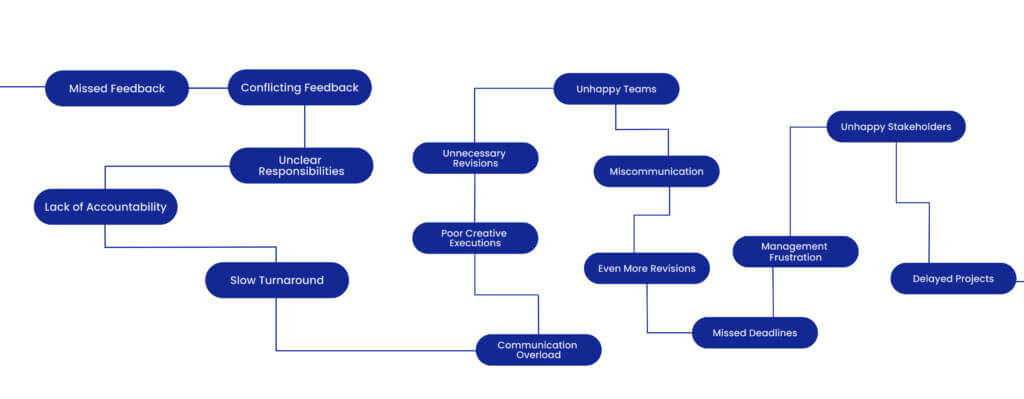Delivering any creative project means grappling with a set of very specific challenges, as well as navigating the unexpected problems that can come up.
As well as managing a team’s clashing creative instincts, project managers need to satisfy the requirements of stakeholders and the organization. All while balancing a drive for quality and efficiency.
Efficient creative project management is crucial for streamlining team workflows and ensuring successful project outcomes.
Achieving this seems daunting at the best of times – but if you’re dealing with dysfunctional workflows and feedback processes, creative workflow management can become a complete nightmare.
Challenges in Efficient Creative Project Management
From people not being fully aligned to confusing feedback, there are plenty of things that can set your creative project back. While some problems can be addressed through good team leadership, a lot of it comes down to how, when, and where you’re gathering and managing feedback.

Let’s break down a few of those common creative workflow problems that creative teams face regularly.
Work Can’t Flow without Alignment
What are you working towards?
Getting aligned on goals and tasks is the foundation of any project. While this should be a priority for all teams, it can be especially challenging for creative teams to achieve.
Todd Henry, author of the creative management book Herding Tigers, believes this is often due to a lack of clarity around expectations: “When your team fails to have a common understanding of what excellence is, people are often (unwittingly) working toward different ends.”
Sometimes this is made worse by external factors. A survey found that only 10% of creative agencies feel the briefs they receive are effective. In the absence of a clear outline or goals, the sheer number of possible directions and the subjective nature of creativity can lead people down many different tracks.
Creative Management vs Time Management
It can take time not only to find but also deliver a winning idea. If your team needs to rush through any of the stages of creativity, output quality will certainly suffer.
In Adobe’s Future of Creative Experiences Report, roughly a third of creatives reported that not having enough time to meet deadlines was a challenge they faced. The survey also found that, on average, creatives were only able to spend 29% of their time on creative work, with the rest taken up by administrative and project management tasks (And in our experience, that often includes chasing review and approvals!).
While there’s a wealth of time management advice out there to help, figuring out what works can feel like a luxury when your team is already under time pressure. Nor can time management skills address the problem of unreasonable time constraints being imposed from above or dysfunctional creative workflows.
Unclear or Broken Feedback
Time constraints are exacerbated by vague feedback that is not thought out, not organized and often, well, uninterpretable.
Often, because creative work is so subjective, people often find it easier to provide a broad opinion about how it makes them feel (like “that first section doesn’t really work for me” or “it needs to pop more”), rather than specific and clear feedback. They may also fall back on non-specific language or sandwich their critique in with praise to avoid causing conflict.
Vague feedback is almost impossible for someone to act on correctly and can lead to time-consuming misunderstandings – plus, it can be deeply frustrating for all involved!
Accommodating New Perspectives and Expectations
The resistance and confusion only gets worse when you introduce feedback from outside of the immediate team.
People involved in a project sporadically may not be aware of the feedback history or the context behind certain creative decisions. They’re also bringing a different set of priorities to the table (See: A Lack of Alignment). These factors can cause their requests to appear unreasonable or arbitrary to those within the team, causing resentment.
As Todd Henry puts it in Herding Tigers: “Creative people appear to be difficult because the expectations for a project keep changing midstream, after they’ve done a tremendous amount of conceptual work that will have to be rehashed just to get back to the starting line.”
Too Many Channels
The involvement of stakeholders and management often means that feedback is spread over different channels, making it difficult and time-consuming to review. Needing feedback and signoffs from multiple different people can result in lengthy delays.
As well as negatively impacting the timeline, this siloed, decentralized, and often contradictory flow of information can leave your team feeling as though they’re going in circles.
And you never want your creatives to give up before the job is done properly.

Streamlining Creative Workflows: What Project Managers Can Do
These challenges are formidable but there are steps you can take to mitigate them and keep things running smoothly. To streamline creative workflows, project managers need to establish clear objectives, ensure effective communication, and have an effective feedback process.
Establish Clear Objectives and Expectations
To ensure alignment, take time to outline the objectives for each stage of the process. Make sure everyone understands what those objectives mean, rather than assuming everyone is on the same page.
Staff at Gallop suggest setting specific goals for each team member as this builds a better mutual understanding of everyone’s unique skillsets and responsibilities, smoothing the way for more efficient collaboration.
Ensure everyone understands the context. When people are aware of the “why” behind what they’re being asked to do, they can tailor their solution to the circumstances more effectively. It will also make it easier for them to process and accept management decisions.
Implement Structured Feedback Channels
Structuring your feedback process can drastically reduce misunderstandings, delays, and conflicting input. It takes some of the uncertainty out of the process for your team, making it a much less stressful and frustrating experience.
Set a framework for feedback (including a timeline, objectives, and requirements for each stage) that everyone is aware of and can commit to. This shouldn’t just be for your team – you should also involve any external stakeholders to decrease the likelihood of delayed feedback derailing the project.
The right tools are essential to streamline the process. Online proofing, for example, can drastically simplify the centralization and consolidation of feedback. It cuts down on misunderstandings and conflicting feedback as it creates accountability, providing a history of all feedback and approval decisions.
You’ll also be freeing your team from those time-consuming creative process management tasks, meaning they can spend more time and energy on their actual creative work.
Keep Communication Open and Flowing
Keeping the door open allows people to seek clarification on any aspects of the brief, goals, or feedback that are unclear. That means less time lost to misunderstandings and unhelpful conflict
Ask questions to understand how your team approaches their work. Neri Karra Sillaman believes that showing an interest in their creative process means they’ll give greater weight to your opinions: “Your team is less likely to listen to your critiques if they feel you don’t understand them and their artistry or perspective.”
Encourage everyone to approach feedback with curiosity as this helps people adopt a more receptive mindset. Academic Spencer Harison has found that creatives who ask open-ended questions (rather than trying to impose control over the situation with narrower ones) receive more feedback and produce better results.
Alignment and Feedback for Smoother Creative Workflow Management
Managing a creative project comes with many challenges, from resistance to feedback within the team to inefficient communication. These issues can come to a head during the feedback cycle, particularly if the processes in place are unclear or dysfunctional.
Focusing on efficient creative project management and streamlining creative workflows allows you to ensure that projects run smoothly and meet all stakeholder requirements.
By ensuring clarity about objectives and expectations, encouraging respectful and open communication, and establishing a clear structure for the feedback process, you can deal with these potential problems and empower everyone to do their best work.





